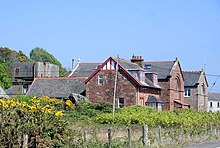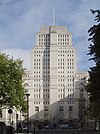Great Cumbrae is the larger of the two islands known as The Cumbraes in the lower Firth of Clyde in western Scotland. The island is sometimes called Millport, after its main town.

Little Cumbrae or Little Cumbrae Island is an island in the Firth of Clyde, in North Ayrshire, Scotland. The island is known locally as Wee Cumbrae.

Millport is the only town on the island of Great Cumbrae in the Firth of Clyde off the coast of mainland Scotland, in the council area of North Ayrshire. The town is 4 miles (6 km) south of the ferry terminal that links the island to the Scottish mainland.

North Ayrshire is one of 32 council areas in Scotland. The council area borders Inverclyde to the north, Renfrewshire and East Renfrewshire to the northeast, and East Ayrshire and South Ayrshire to the east and south respectively. The local authority is North Ayrshire Council, formed in 1996 with the same boundaries as the district of Cunninghame which existed from 1975 to 1996.

The Firth of Clyde is the mouth of the River Clyde. It is located on the west coast of Scotland and constitutes the deepest coastal waters in the British Isles. The firth is sheltered from the Atlantic Ocean by the Kintyre peninsula, which encloses the outer firth in Argyll and Ayrshire. The Kilbrannan Sound is a large arm of the Firth of Clyde, separating the Kintyre Peninsula from the Isle of Arran. Within the Firth of Clyde is another major island – the Isle of Bute. Given its strategic location at the entrance to the middle and upper Clyde, Bute played a vital naval military role during World War II.

The County of Bute, also known as Buteshire, is a historic county and registration county of Scotland.
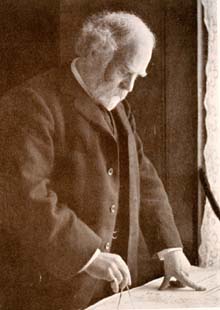
Sir John Murray was a pioneering Canadian-born Scottish oceanographer, marine biologist and limnologist. He is considered to be the father of modern oceanography.
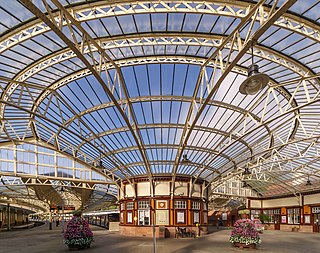
Wemyss Bay railway station serves the village of Wemyss Bay, Inverclyde, Scotland. The station is a terminus on the Inverclyde Line, about 26 miles (42 km) west of Glasgow Central. The station incorporates the Caledonian MacBrayne ferry terminal connecting mainland Scotland to Rothesay on the Isle of Bute. The station is managed by ScotRail.

Field Studies Council is an educational charity based in the UK, which offers opportunities for people to learn about and engage with the outdoors.
David Robertson FLS, FGS (1806–1896) was a Scottish naturalist and geologist who founded the University Marine Biological Station, Millport.

The Scottish Association for Marine Science (SAMS) is one of Europe's leading marine science research organisations, one of the oldest oceanographic organisations in the world and is Scotland's largest and oldest independent marine science organisation.
Alfred Merle Norman was an English clergyman and naturalist.
Scottish Marine Station may refer to:
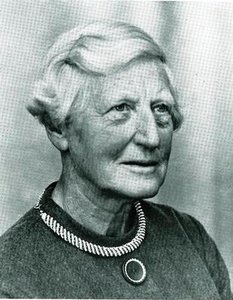
Sheina Macalister Marshall was a Scottish marine biologist who dedicated her life to the study of plant and animal plankton. She was an authority on the copepod Calanus. She worked at the Marine Biological Station at Millport, Cumbrae in Scotland from 1922-1964.
Events from the year 1964 in Scotland.
Ronald Ian Currie FRSE CBE was a Scottish marine biologist. He was known generally as Ron Currie.

John Robertson Henderson CIE FRSE FZS FLS was a Scottish zoologist who specialized in the taxonomy of marine crustaceans, particularly the decapods, and worked on specimens collected by the oceanic research vessels Investigator and Challenger. From 1892 until 1911 he was Professor of Zoology at Madras Christian College in India. From 1908 to 1920 he was Superintendent of the Government Museum in Madras. He also took an interest in numismatics and Indian history.

FSC Millport, run by the Field Studies Council, is located on the island of Great Cumbrae in the Firth of Clyde, Scotland. The field centre was formerly known as the University Marine Biological Station Millport (UMBSM), a higher education institute run by the University of London in partnership with Glasgow University but was closed due to the withdrawal of higher education funding in 2013. FSC reopened the centre in 2014 and continues to host and teach university, school and college groups and to support and host research students from all over the world, whilst also extending its educational reach and providing a variety of courses in natural history and outdoor environmental activities for adult learners and families to enjoy. The centre is a very popular conference venue hosting many international events. The Robertson Museum and Aquarium is open to visitors between March and November. The centre also functions as a Meteorological Office Weather Station and Admiralty Tide Monitor.
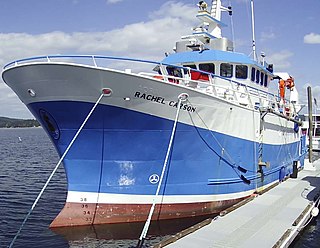
R/V Rachel Carson is a research vessel owned and operated by the University of Washington's School of Oceanography, named in honor of the marine biologist and writer Rachel Carson. The vessel is part of the UNOLS fleet. It is capable of conducting operations within the Salish Sea and coastal waters of the western United States and British Columbia. She can accommodate up to 28 persons, including the crew, for day operations, while up to 13 can be accommodated for multi-day operations.

